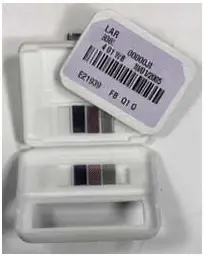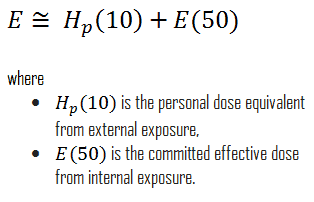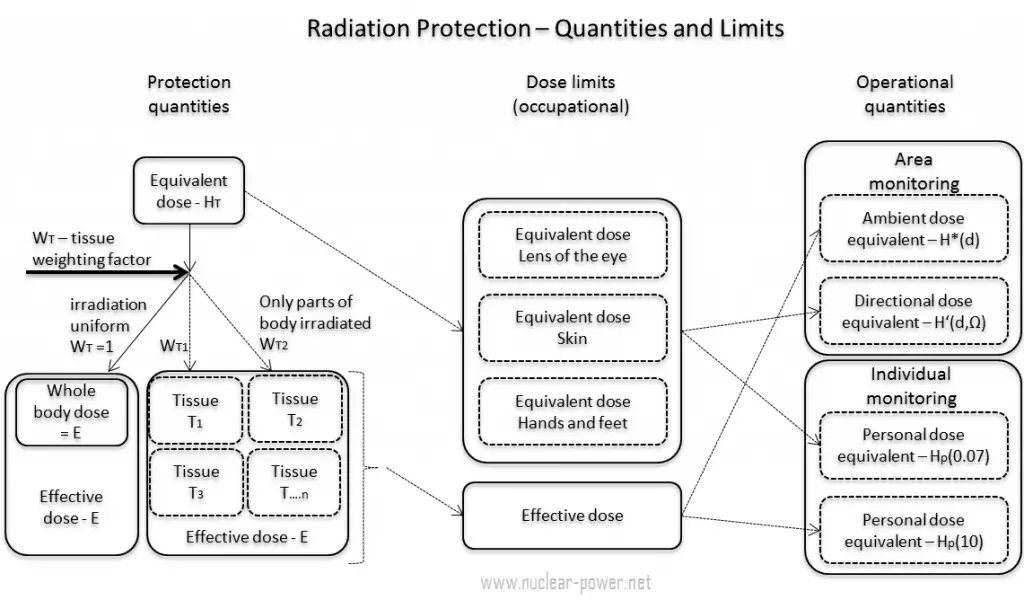
Film badges, and film badge dosimeters, are small portable devices for monitoring cumulative radiation dose due to ionizing radiation. The principle of operation is similar to X-ray pictures. The badge consists of two parts: photographic film and a holder. The film is contained inside a badge. The piece of photographic film is sensitive material, and it must be removed monthly and developed. The more radiation exposure, the more blackening of the film. The blackening of the film is linear to the dose, and doses up to about 10 Gy can be measured. Film badge dosimeters apply to situations where real-time information is not needed. Still, accumulated dose monitoring records are desired for comparison to field measurements or for assessing the potential for long-term health effects. In dosimetry, the quartz fiber and film badge types are superseded by TLDs and EPDs (Electronic Personal Dosimeter).
Film badge dosimeters are for one-time use and cannot be reused. A film badge dosimeter is a dosimeter worn at the body’s surface by the person being monitored and records the radiation dose received. The film badge measures and records radiation exposure due to gamma rays, X-rays, and beta particles. The badge incorporates a series of filters (lead, tin, cadmium, and plastic) to determine the quality of the radiation. The filters use various densities of plastic or even label material to monitor beta particle emission. It is typical for a single badge to contain a series of filters of different thicknesses and materials; the precise choice may be determined by the environment to be monitored.
Examples of filters:
- An open window makes it possible for weaker radiations to reach the film.
- A thin plastic filter that attenuates beta radiation but passes all other radiations
- A thick plastic filter passes all but the lowest energy photon radiation and absorbs all but the highest beta radiation.
- A dural filter progressively absorbs photon radiation at energies below 65 keV and beta radiation.
- A tin/lead filter of a thickness that allows an energy-independent dose response of the film over the photon energy range 75 keV to 2 MeV.
- A cadmium lead filter can be used for thermal neutron detection. The capture of neutrons ((n, gamma) reactions) by cadmium produces gamma rays which blacken the film, thus enabling assessment of exposure to neutrons.
A film dosimeter must be worn on a position of the body representative of its exposure. Therefore, the badge is typically worn outside clothing, around the chest or torso, to represent dose to the “whole body.” Today, film badges are still in use worldwide and worn by people such as x-ray technicians and nurses who may be exposed to radiation. On the other hand, there has been a trend towards using other dosimeter materials that are less energy dependent and more accurately assess radiation dose. Film dosimeters are usually replaced by thermoluminescent dosimeters (TLDs), aluminium oxide-based dosimeters, and electronic personal dosimeters (EPDs).
Advantages and Disadvantages of Film Dosimeters
Advantages of Film Dosimeters
- A film badge as a personnel monitoring device is very simple, and therefore they are not expensive.
- A film badge provides a permanent record.
- Film badge dosimeters are very reliable.
- A film badge measures and records radiation exposure due to gamma rays, X-rays, and beta particles.
Disadvantages of Film Dosimeters
- Film dosimeters usually cannot be read on-site; instead, they must be sent away for development.
- Film dosimeters are for one-time use only and cannot be reused.
- Exposures of less than 0.2 mSv (20 millirems) of gamma radiation cannot be accurately measured.
Radiation Dose Measuring and Monitoring
In previous chapters, we described the equivalent dose and the effective dose. But these doses are not directly measurable. For this purpose, the ICRP has introduced and defined a set of operational quantities that can be measured and intended to provide a reasonable estimate for the protection quantities. These quantities aim to provide a conservative estimate for the value of the protection quantities related to an exposure avoiding both underestimation and too much overestimation.
Numerical links between these quantities are represented by conversion coefficients, which are defined for a reference person. An internationally agreed set of conversion coefficients must be available for general use in radiological protection practice for occupational exposures and exposures of the public. Computational phantoms are used for dose assessment in various radiation fields to calculate conversion coefficients for external exposure. Biokinetic models for radionuclides, reference physiological data, and computational phantoms are used for calculating dose coefficients from intakes of radionuclides.
A set of evaluated data of conversion coefficients for protection and operational quantities for external exposure to a mono-energetic photon, neutron, and electron radiation under specific irradiation conditions is published in reports (ICRP, 1996b, ICRU, 1997).
 In general, the ICRP defines operational quantities for the area and individual monitoring of external exposures. The operational quantities for area monitoring are:
In general, the ICRP defines operational quantities for the area and individual monitoring of external exposures. The operational quantities for area monitoring are:
- Ambient dose equivalent, H*(10). The ambient dose equivalent is an operational quantity for area monitoring of strongly penetrating radiation.
- Directional dose equivalent, H’ (d, Ω). The directional dose equivalent is an operational quantity for area monitoring weakly penetrating radiation.
The operational quantities for individual monitoring are:
- Personal dose equivalent, Hp(0.07). The Hp(0.07) dose equivalent is an operational quantity for individual monitoring to assess the dose to the skin, hands, and feet.
- Personal dose equivalent, Hp(10). The Hp(10) dose equivalent is an operational quantity for individual monitoring to assess the effective dose.
Special Reference: ICRP, 2007. The 2007 Recommendations of the International Commission on Radiological Protection. ICRP Publication 103. Ann. ICRP 37 (2-4).
Dose Limits
See also: Dose Limits
Dose limits are split into two groups, the public and occupationally exposed workers. According to ICRP, occupational exposure refers to all exposure incurred by workers in the course of their work, except for
- excluded exposures and exposures from exempt activities involving radiation or exempt sources
- any medical exposure
- the normal local natural background radiation.
The following table summarizes dose limits for occupationally exposed workers and the public:

Source of data: ICRP, 2007. The 2007 Recommendations of the International Commission on Radiological Protection. ICRP Publication 103. Ann. ICRP 37 (2-4).
According to the recommendation of the ICRP in its statement on tissue reactions of 21. April 2011, the equivalent dose limit for the eye lens for occupational exposure in planned exposure situations was reduced from 150 mSv/year to 20 mSv/year, averaged over defined periods of 5 years, with no annual dose in a single year exceeding 50 mSv.
Limits on effective dose are for the sum of the relevant, effective doses from external exposure in the specified period and the committed effective dose from intakes of radionuclides in the same period. For adults, the committed effective dose is computed for 50 years after intake, whereas for children, it is computed for the period up to 70 years. The effective whole-body dose limit of 20 mSv is an average value over five years, and the real limit is 100 mSv in 5 years, with no more than 50 mSv in any year. Toward that end, employers carefully monitor the exposure of these individuals using instruments called dosimeters worn on a position of the body representative of its exposure. In most situations of occupational exposure, the effective dose, E, can be derived from operational quantities using the following formula:

Sievert – Unit of Equivalent Dose
In radiation protection, a sievert is a derived unit of equivalent dose and effective dose. The sievert represents the equivalent biological effect of depositing a joule of gamma rays energy in a kilogram of human tissue. Unit of sievert is important in radiation protection and was named after the Swedish scientist Rolf Sievert, who did a lot of the early work on radiation dosimetry in radiation therapy.
As was written, the sievert is used for radiation dose quantities such as equivalent dose and effective dose. Equivalent dose (symbol HT) is a dose quantity calculated for individual organs (index T – tissue). The equivalent dose is based on the absorbed dose to an organ, adjusted to account for the effectiveness of the type of radiation. An equivalent dose is given the symbol HT. The SI unit of HT is the sievert (Sv) or but rem (roentgen equivalent man) is still commonly used (1 Sv = 100 rem).
Examples of Doses in Sieverts
We must note that radiation is all around us. In, around, and above the world we live in. It is a natural energy force that surrounds us, and it is a part of our natural world that has been here since the birth of our planet. In the following points, we try to express enormous ranges of radiation exposure, which can be obtained from various sources.
- 0.05 µSv – Sleeping next to someone
- 0.09 µSv – Living within 30 miles of a nuclear power plant for a year
- 0.1 µSv – Eating one banana
- 0.3 µSv – Living within 50 miles of a coal power plant for a year
- 10 µSv – Average daily dose received from natural background
- 20 µSv – Chest X-ray
- 40 µSv – A 5-hour airplane flight
- 600 µSv – mammogram
- 1 000 µSv – Dose limit for individual members of the public, total effective dose per annum
- 3 650 µSv – Average yearly dose received from natural background
- 5 800 µSv – Chest CT scan
- 10 000 µSv – Average yearly dose received from a natural background in Ramsar, Iran
- 20 000 µSv – single full-body CT scan
- 175 000 µSv – Annual dose from natural radiation on a monazite beach near Guarapari, Brazil.
- 5 000 000 µSv – Dose that kills a human with a 50% risk within 30 days (LD50/30) if the dose is received over a very short duration.
